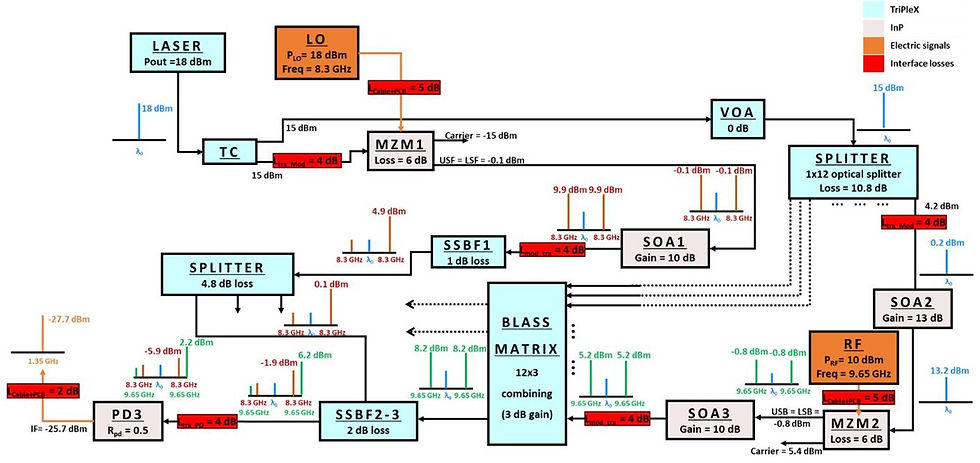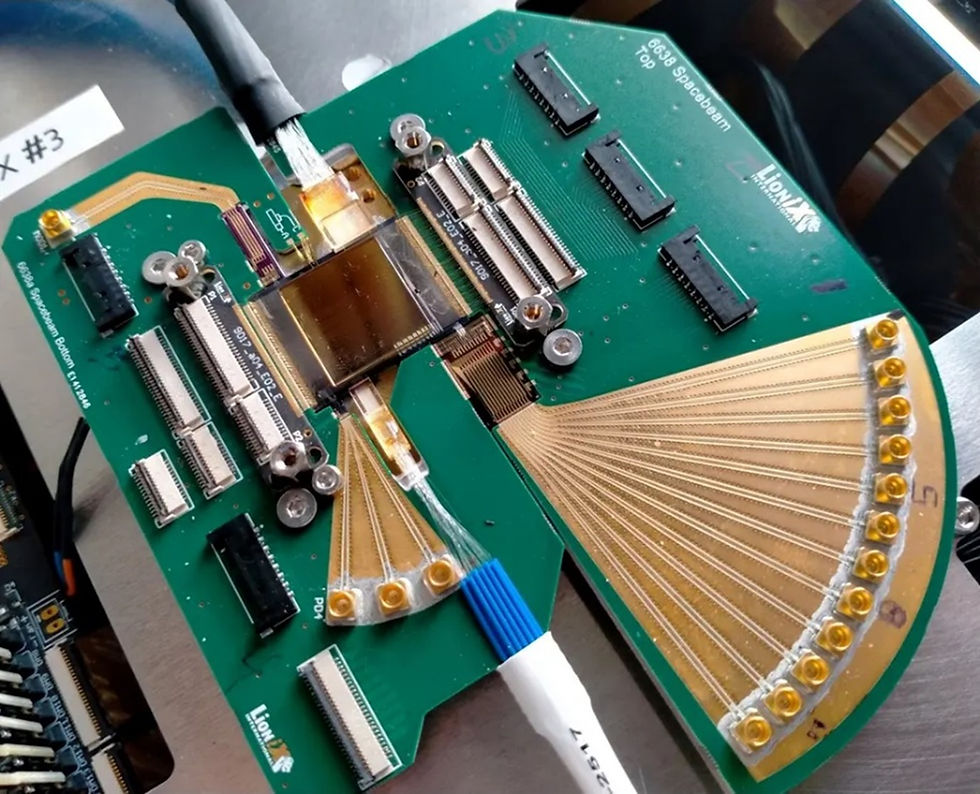Integrated Photonics Modules for Enhanced Spaceborne Synthetic Aperture Radars
- Latitude Design Systems

- Feb 6, 2024
- 3 min read
Abstract
Synthetic aperture radar (SAR) is an important remote sensing technique for Earth observation from space. The EU-funded HORIZON 2020 project SPACEBEAM developed an advanced photonic integrated circuit to enable continuous wideband beamforming and frequency conversion for direct digitization of signals in SAR systems. The photonic chip combines active components on indium phosphide with passive components on silicon nitride into a hybrid integrated module. This photonic receiver will allow future SAR instruments to achieve instantaneous wide-area imaging at high resolution using scan-on-receive beamforming. This article summarizes the motivation, design approach, and results of the SPACEBEAM project, based on a paper published in the Journal of Lightwave Technology.
Introduction
Earth observation from space has become indispensable for monitoring climate change and pursuing sustainability goals. Satellite images enable precise tracking of parameters like vegetation health, deforestation, glacier retreat, pollution, and extreme weather events. However, conventional optical imaging satellites have limitations due to dependence on favorable weather conditions and sunlight. Synthetic aperture radar (SAR) provides a valuable complementary capability by using microwave signals to form high-resolution images of the Earth's surface independent of weather or sunlight. As SAR instrumentation continues to advance, instantaneous wide-area high-resolution imaging is becoming feasible through techniques like scan-on-receive (SCORE) beamforming. To enable these capabilities, the European Union funded the SPACEBEAM project to develop a photonic integrated circuit for advanced signal processing in spaceborne SAR systems.
Motivation for Photonic Integrated Circuits in SAR
SAR systems work by synthesizing a large virtual aperture antenna using signal returns from multiple smaller physical apertures as a satellite moves along its flight track. This allows a SAR instrument to achieve fine spatial resolution comparable to a large physical antenna. Conventional SAR systems transmit a wide beam that illuminates a swath on the ground, then receive radar echoes using a single antenna pattern. SCORE SAR aims to improve on this by steering multiple simultaneous antenna beams to receive echoes across the swath from each transmission, as illustrated in Figure 1. This enables higher resolution, sensitivity, and coverage rate.

The SPACEBEAM project sought to implement SCORE SAR capabilities using photonic integration. The photonic module was intended to provide key functionality including:
Continuous wideband beamforming for signals from a 12-element antenna array
Capacity to synthesize up to 3 simultaneous beams
Frequency downconversion for direct digitization of SAR signals
Low power consumption (~3.5 W) using integrated phase shifters
Photonic integration was chosen due to its advantages for wideband signal processing, beamforming, and frequency conversion compared to traditional electronic systems. The photonic approach would enable meeting the demanding performance requirements for future high-capability SAR missions.
Design of the Photonic Integrated Circuit
To achieve the project goals, the SPACEBEAM consortium designed a photonic integrated circuit (PIC) to implement the required beamforming and downconversion functions, as shown in the schematic in Figure 2.

The PIC combines optical components on two material platforms:
Active components on indium phosphide (InP) for optical gain, modulation, and detection
Passive components on silicon nitride (TriPleX) for low-loss waveguides, routing, and beamforming
As shown in the schematic, a laser is split into two paths. One path is modulated by a local oscillator (LO). The other is split into 12 channels and modulated with SAR receiver signals using Mach-Zehnder modulators (MZMs). This produces optical sidebands for the LO and signals which are heterodyned in photodiodes to downconvert the signals. Semiconductor optical amplifiers integrated with each modulator boost the optical power. Filtering, splitting, and combining functions are implemented on the TriPleX chip. A 12x3 switching matrix enables reconfigurable beamforming by controlling the delay, amplitude, and phase shift applied to each channel.
The hybrid PIC assembly developed by the project is shown in Figure 3. It combines:
InP gain chip for the laser
InP modulator chips with MZM arrays
TriPleX beamforming and filter chip
InP photodiode array chip

The assembly is wire-bonded and mounted on a printed circuit board, as pictured in Figure 4.

To control the PIC, the project also developed custom control electronics called SaBox, shown in Figure 5.

Results
Within the SPACEBEAM project, LioniX International coordinated the design, fabrication, and evaluation of the photonic modules. Initial tests successfully demonstrated the frequency downconversion capability, which represents a key building block. Project partners also evaluated beamforming performance and conducted environmental testing towards space qualification. With further development, systems based on the SPACEBEAM photonic integrated circuit could enable a new generation of high-capability SAR instruments for Earth observation.
Conclusion
The SPACEBEAM project achieved an important milestone towards scan-on-receive SAR systems by developing a photonic receiver module with integrated beamforming and frequency conversion. The hybrid integrated circuit combines indium phosphide modulators and amplifiers with a low-loss TriPleX passive circuit and provides reconfigurable 12x3 beamforming to enable wide-area continuous imaging. While further work is needed to space-qualify the design, the results highlight the potential of photonic integration to enhance future spaceborne SAR and remote sensing systems. The initial SPACEBEAM module provides a foundation to build upon for more advanced photonic SAR receivers.
Reference




Comments